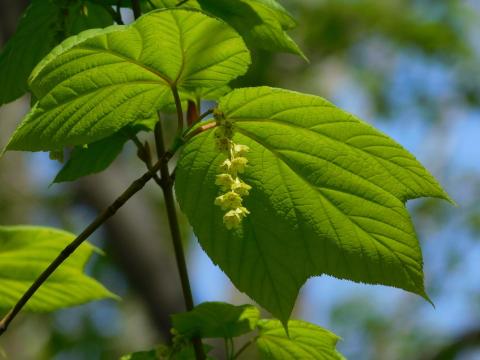Striped maple trees (Acer pensylvanicum) are part of the 10 percent, but a new study found something even more interesting - rather than remaining fixed during their lifetime, 54 percent changed sexes over a four-year period, with some switching at least twice. But not without cost. Though only female trees can make seeds, male trees usually outnumber female trees by more than three to one. Since the study started in 2014, 75 percent of trees that died were female. This is an anomaly. In other understory trees, such as the Jack-in-the-pulpit, females are usually larger or healthier since it takes more energy to be female and to produce fruits and seeds.
The size of the tree doesn't seem to influence what sex a tree is.

Striped maple tree leaves and flowers. Credit: Jennifer Blake-Mahmud, Ph.D.
The striped maple is a slow-growing species that reaches heights of about 30 to 50 feet and thrives at medium to high elevations along the Appalachian Mountains from Georgia to Nova Scotia. Understory trees like the striped maple, which grow beneath the forest canopy, can become less healthy for many reasons: insects chew on them, deer use them for antler rubs, large trees fall on them during storms or they can suffer through droughts.
Over longer periods, these stressful conditions may result in increasing numbers of females compared with males in striped maple tree populations. More females likely mean more seeds and more seedlings of striped maples. At first this might seem like a good thing, but that might not necessarily be the case. Since the female death rate is much higher than the male death rate, the number of trees in these populations may decline over the long-run.
Upcoming research will look at how important certain environmental factors may be in determining a striped maple tree's sex. Now scientists are looking at the concentration of sugar stored in sap to see if trees with more sugar reserves are more likely to be female. They are also looking at whether they can trigger a sex change by causing an injury, such as cutting off a branch.





Comments